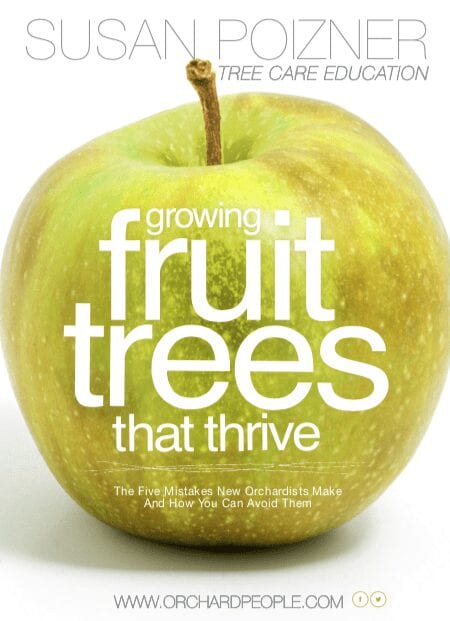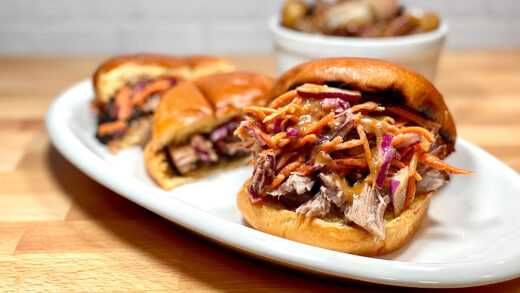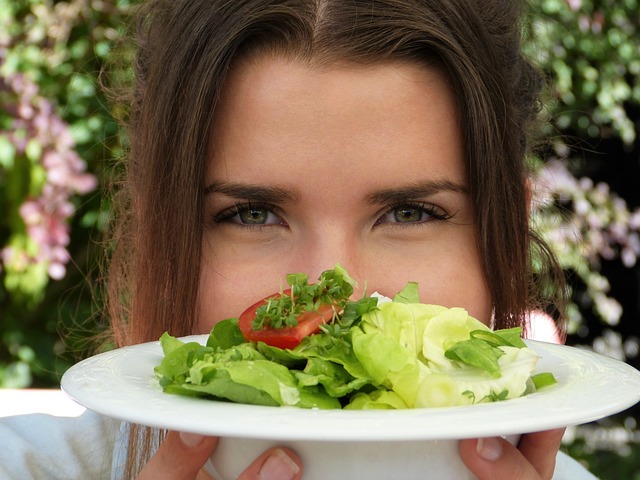
Wood chips can be very beneficial for fruit trees. Lots of growers spread wood chips over the roots of their trees, and often they do this in the early spring. Mulching with wood chips comes with lots of well-known benefits:
- Wood chips keep moisture in the soil that tree roots can get access to.
- They insulate the soil, protecting roots from extreme temperatures.
- They suppress weeds and even improve soil quality by adding organic matter to the soil as it decomposes.
But, choosing the best wood chips for fruit trees can be tricky and some wood chips are more beneficial than others. So in this article we will explore your wood chip options. And we will also tackle the big question that many gardeners and fruit tree growers worry about: Is it safe to put wood chip mulch around fruit trees? Or can these mulches spread diseases?
The answers may surprise you. So let’s dig in!

The Big Question: Purchased Vs Arborist Wood Chips
Let’s start with the big question. Should you use arborist wood chips or is it better, and safer, to buy wood chips from your local garden center? Everyone seems to have an opinion on that. But when you consider this from a scientific perspective, one of those two options comes out on top.
Bark Mulch and Fruit Trees
When you buy wood mulch from a garden center it will primarily be made up of tree bark. That’s because commercial wood mulch is a by-product of the lumber industry. Before processing logs into lumber, mills need to strip off the bark. And rather than throw that bark away, it’s bagged up and sold as garden mulch.
The great thing is that bark mulch looks good. The chips are uniformly sized and consistent in look, without the presence of small twigs and leafy bits. Sometimes this type of wood mulch will be dyed black or red to make more of a visual impact. If you spread this mulch thickly around trees and plants, it will deter weeds for a long time – because it takes a long time to break down. And that is part of the problem.

Tree bark naturally decomposes slowly because the function of bark is to shield the inner parts of the tree from pests, pathogens, and environmental challenges. So if you were hoping that this commercial mulch would quickly decompose and contribute organic matter to the soil, you may be disappointed. This could take a very long time.
If your goal is to keep moisture in the soil around your tree’s root system, that may also not work as well as you would like, according to Linda Chalker-Scott, Professor of Horticulture at Washington State University and the award-winning author of six books including How Plants Work: The Science Behind the Amazing Things Plants Do.
“Bark has many functions, and one of the functions is to keep water inside the living tree,” she told me in episode #102 of the Orchard People podcast.
“So there’s a lot of waxes that are impregnated into the bark material. If you make a mulch that’s only out of this outer covering, you end up having a mulch that is pretty water repellent and doesn’t absorb water. And it doesn’t really allow itself to become part of the soil system.”
At least, it won’t become part of the soil system in any big hurry.
So now, let’s see how arborist mulch compares.

Arborist Wood Chips and Fruit Trees
Arborist wood chips are completely different. While store-bought wood chips are a by-product of the lumber industry that contains only tree bark, arborist wood chips are made up of a mix of freshly chipped branches, leaves, and possibly smaller tree trunks or stems.
These chips may come from healthy trees that suffered damage during a storm. Or they could come from trees at the end of their lifespan. Arborists also may be taking down a diseased or pest infested trees and that’s a topic that we will discuss later in this article.
Because arborist wood mulch is made up of different parts of the tree, it will not look as pretty as bark mulch. And yet, this stuff comes from a living tree and if used soon after chipping, it can be packed with nutrients that your fruit tree will love. Here are just a few reasons why many consider arborist mulch the best wood mulch for fruit trees:
- Fresh arborist wood chips offer a spectrum of nutrients including nitrogen, phosphorus, potassium, calcium, magnesium, and sulfur.
- They also contain the beneficial microorganisms that cover the surfaces of the leaves and branches and these microbes, including beneficial fungi and bacteria. These microbes break down organic matter and release micronutrients like iron, manganese, zinc, and copper.
- And while the microbes are munching away on your arborist wood chips and releasing these nutrients, they are breaking down the wood into organic matter, so you will see that this type of mulch decomposes faster than commercial bark mulch.
So, arborist wood mulch breaks down faster and releases more nutrients and in the process it improves soil structure and supports tree and plant health and growth. If you are growing fruit trees and want them to be strong and well-nourished, then this seems like a great choice.
So, why don’t growers scramble to get arborist wood chips to use on their fruit trees? Many of us are afraid that wood chips from diseased trees or pest infested trees can spread to our fruit trees. And fruit tree diseases can be devastating, ruining the health of our trees and the quality of the harvest.
So, are arborist wood chips safe to use on fruit trees? Let’s explore that next.
Can Wood Chips Spread Disease to Your Fruit Trees?
One reason people buy bark mulches from their local garden centers is because they know what they’re getting. You know it will look good. And you can be pretty certain that commercial bark mulch will not harbor disease.
But when you have an arborist deposit wood chips in your front yard or on your driveway, you don’t necessarily know where it came from. Could it have come from a diseased tree? The answer is yes. But even if the tree is diseased, there is a chance your tree might not have a problem with that.
That’s because not all trees are susceptible to all diseases. While the fungal disease black knot can easily spread from one plum tree to another, that disease won’t be a problem if you are growing pears. And similarly, if the arborist wood chips come from a diseased maple, that probably won’t be a problem for your apple tree.
Linda Chalker-Scott explains that you need three things for a disease to spread and it’s part of a model called the “Disease triangle.” You have to have a pathogen. You have to have a host, and then you have to have the right environmental conditions.”
So if the wood chips come from a diseased maple tree, the pathogen is in the chips. Often fungal diseases spread in damp, rainy weather, so if the weather is damp and rainy, well then, you have the right environmental conditions.
But at this point, you still need a host. So if you’re growing a maple tree, then the disease could possibly spread to that tree. But if you’re growing apples trees that aren’t susceptible to this fungal disease, you don’t have much to worry about.

Fruit Tree Care Newsletter
Sign up for our monthly newsletter and we will send you our eBook “Growing Fruit Trees That Thrive.” You can unsubscribe at any time.
As an extra bonus, if you soil is healthy, these pathogens won’t thrive. That’s because healthy soil will have a wide range of beneficial or neutral bacterial or fungal microbes that will compete with the pathogen in the wood chips. The hope is that the good guys will win!
And Linda says studies prove that.

Phytophthora and Armillaria are both types of fungi that can cause serious plant diseases and they affect a wide range of hosts across various environments. But these pathogens do well in poorly oxygenated, compacted, poorly drained soils. So if you have used arborist wood chips for years, and your soil is healthy, pathogens like these ones will not be active.
Still, it’s wise to take a cautious approach, especially when it comes to fruit trees. Talk to your local arborist. Find out where their wood chips come from. And ask them to avoid giving you chips that come from diseased fruit trees.
Emerald Ash Borer and Wood Chips
So that brings us to the next question. Can arborist wood chips contain pests? One of the biggest tree pest problems we are facing in North America at the moment is Emerald Ash Borer (EAB) which is an invasive species on this continent.
It has no natural predators to keep its population in check and since first being identified in North America in 2002, it has caused the death of millions of ash trees across the continent.
The borer larvae feed on the inner bark of ash trees, making it hard for the tree to transport water and nutrients. Eventually this will lead to the tree’s death.
So, would you want wood chips made from a tree that died as a result of this invasive pest? Could the eggs or larvae survive the chipper?
If you do use it, Linda suggests that it would be good to chip the wood very finely to destroy any remaining critters hiding in the wood. Once the tree is chipped up, exposure to sunlight and air will dry the wood chips quickly. At that point, the conditions aren’t ideal for any pests that might have survived the chipping process.
Saying that, there are rules in both Canada and in the US aimed at preventing the spread of the emerald ash borer. Some of the guidelines include strict restrictions on moving emerald ash borer infected firewood or wood chips from areas known to be infested with EAB to areas that are not
So, if you have an ash tree that was removed due to this serious pest, you can have it finely chipped and use it on your site. But avoid moving it to another area where you could potentially spread the problem further.
Why Black Walnut and other Allelopathic Wood Chips Might Not be a Problem
On the internet, there is lots of chatter about allelopathic trees and how you should avoid using them for wood chips. The theory is that allelopathic trees release chemicals that can inhibit the growth of surrounding plants. And the fear is that if your arborist mulch is made up of bits of an allelopathic tree, that these chemicals could actually harm or kill your tree.
A example of an allelopathic tree is the black walnut (Juglans nigra), which is famous for producing juglone, a substance that is said to be toxic to many plants and trees. But here again, Linda isn’t worried. She explains why:
“There is absolutely no evidence that trees that have, chemicals in them naturally that can have effects on plants. So, all those chemicals that are in the wood chips break down fairly rapidly. Microbes break them down and use them up and so they don’t stick around at levels that would make any kind of a problem for your landscape.”

Do Wood Chips Make Soil Acidic? Hardwood vs Softwood Mulch
Another concern is that certain types of wood chips might make your soil more acidic. And those of us who grow fruit trees including apples, pears, and cherries, know that fruit trees can be fussy and do not thrive in very acidic soil.
It is true that different types of wood—such as softwoods and hardwoods— can affect the soil’s acidity or alkalinity. But studies show that in general, the effect of wood chips on soil pH is minor and occurs over a prolonged period, making it a slow and gradual process that rarely results in dramatic changes.
To explore that, let’s see what the difference is between hardwood and softwood trees.
- Softwood chips come from conifers like pine and spruce trees. And they are commonly thought to lower soil pH, making it more acidic.
- Hardwood chips are from deciduous trees and they are less acidic and so people think they might lower soil pH.
But studies show that softwood and hardwood chips don’t really change soil pH much when they are used as mulch. That’s because the mulch sits on the soil surface, and any leaching of acidic compounds into the soil is diluted by rainwater and irrigation.
And of course, beneficial microbes work hard to break down the hardwood or softwood mulches and as they do, the pH of the remaining organic matter becomes relatively neutral.

Finally, do Wood Chips Rob Nitrogen from the Soil?
Many worry that wood chips may deplete nitrogen from the soil, potentially leading to deficiencies in young fruit trees. And it is true that as wood chips decompose, they can temporarily reduce soil nitrogen availability. This happens because beneficial microbes use nitrogen to fuel the process of breaking down the mulch.
But, when wood chips are applied as mulch on the soil surface, the impact on nitrogen levels is minimal. This effect might be limited to the soil’s top layer, leaving deeper tree roots unaffected. Over time, those decomposing wood chips will boost the soil’s organic matter, improve soil structure, and gradually release nitrogen and other nutrients back into the soil.
Essentially, the microbes are “borrowing” the nitrogen, and they will give it back later, bringing the added benefits of improved soil structure and a wealth of released nutrients that your fruit trees will love. Want to get those microbes to work quicker? Consider spraying your fruit trees with homemade fruit tree sprays. These sprays boost tree photosynthesis which will, in turn, encourage your tree to release sugars into the soil that feed soil organisms.
Where to get Free Arborist Mulch
So, Linda Chalker-Scott says that the best mulch for fruit trees is arborist mulch! But how do you get it? Try these methods:
- If you see an arborist working nearby, ask if you can take the chips off their hands. It could save them disposal fees.
- Reach out to local arborist companies about dropping mulch at your place which will save them the expense of finding somewhere else to deposit the wood chips.
- Use ChipDrop.com to get a free woodchips delivered! This wonderful online app links up homeowners who want wood chips with arborists who would like to dispose of them! It won’t cost you a penny, and you can request non-fruit tree mulch if disease is a concern.
- Or, if you have a big property and regularly need to get rid of tree branches, you can buy your own wood chipper and turn it into high quality mulch when you need it.
If you do manage to find an arborist who will give you wood chips, there is also a down side. You can’t choose the quantity you’ll receive, so be prepared to share a huge pile of wood mulch with friends, family, neighbors and anyone else who will take them off your hands. Also, arborist wood chip delivery times might not suit your perfect schedule, but if you’re flexible, it’s a great option.

Compost, Straw, and Even Paper Mulch Options
Mulching is wonderful for fruit trees and there are other options as well. You can mulch your trees with compost, straw, or even shredded paper! Learn more in our Ultimate Guide to Fruit Tree Mulches.
But if it’s the best wood mulch that you’re looking for, you’re going to want to get your hands on some arborist mulch. It can be a bit of a task to find a good (and free!) supplier, but the benefits to your plants and fruit trees makes it worth the effort!
Q&A on the Best Wood Chips for Fruit Trees
Q: What should I do if wood chips come from trees treated with persistent herbicides?
A: Wood chips from trees treated with persistent herbicides can be very damaging to fruit trees and other plants. If you suspect the wood chips might be contaminated, it’s safest to avoid using them around sensitive plants. Instead, use these chips for non-plant areas like walkways, or dispose of them properly.
Q: Should arborist mulch be composted before use?
A: Composting arborist wood chips before using them as a mulch isn’t always necessary. But, if you are concerned that there might be contaminants in the mulch, it might be a good idea. Composting your wood chips will allow beneficial microbes to help break down the chips. And that, together with warmth and aeration will help tackle potential contaminants, disease spores, and surviving pests.
Q: Are commercial bark chips ever useful?
A: Yes, commercial bark chips can be useful for creating walkways in gardens, offering a nice-looking path that won’t break down quickly. Finer, decomposed wood chips, especially those showing mycelium growth, are excellent for planting beds and around fruit trees, where they contribute to soil health and plant growth.
Q: Are there concerns about mulching with wood chips in areas prone to forest fires?
A: Be cautious if you are using wood chips and you live in a fire-prone area. It’s important to maintain a safe distance between wood chip mulch and structures, and using non-flammable mulches near buildings in order to help mitigate fire hazards.
Q: Is sawdust good for mulch?
A: Sawdust can be used as part of a mulch mix but isn’t ideal on its own. It tends to compact, reducing soil aeration and water penetration. If you have sawdust, mix it with larger, coarser materials like wood chips to improve its properties. You can explore other mulch options in our Ultimate Guide to Fruit Tree Mulches.
Q: Are pine needles good for mulch?
A: Yes, pine needles make excellent mulch, especially for acid-loving plants. They decompose slowly, improve soil structure, and help maintain moisture without compacting. Pine needles are particularly beneficial in areas around fruit trees that prefer acidic conditions.
Q: Is colored mulch safe to use in my garden?
A: Colored mulch is generally safe as the dyes used are usually non-toxic to plants and animals. However, it’s essential to choose mulch colored with natural, vegetable-based dyes. Be mindful that the aesthetic benefits of colored mulch may fade over time due to exposure to sunlight.
Q: Do you need to add fertilizer to mulch?
A: It’s not necessary to add fertilizer directly to mulch. Mulch itself doesn’t replace the nutrients plants need from the soil but helps maintain moisture and soil temperature, and reduces weed growth. If your soil test indicates a deficiency, apply fertilizer directly to the soil, not the mulch.
Q: Can mulch be too thick?
A: It depends on your soil type. If you have hard, clay soil a thick layer of mulch can be problem as it can retain too much water leaving tree roots damp and soggy and vulnerable to root rot and fungal diseases. To be safe, use a 2-4 inch layer of mulch. It will decompose and then you can add the same amount the following year.
Q: Should I remove old mulch before adding new mulch? A: It’s not always necessary to remove old mulch before adding new mulch. If the old layer has decomposed and integrated into the soil, you can simply add a new layer on top. However, if the mulch has formed a thick, impermeable layer, it’s a good idea to remove some before adding more.

#Wood #Chips #Fruit #Trees #Arborist #Mulch #Safe




